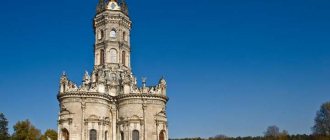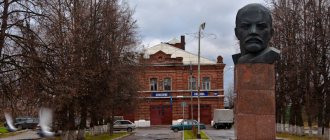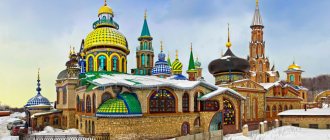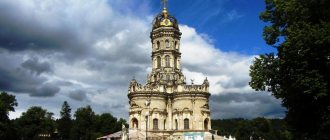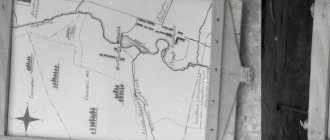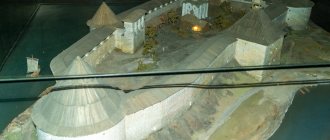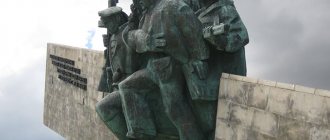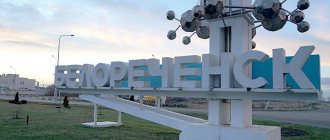| Sights Ancient estates Museums Vacation spots Reviews, stories and routes of tourists Excursions to Podolsk for one day Where to stay in Podolsk |
Quarters on the banks of the Pakhra River, bearing the legacy of Tsarist Russia and the austerity of the Soviet era, surrounded by many industrial enterprises, interspersed with public gardens and forest parks - this is one of the largest cities in the Moscow region - Podolsk.
Podolsk is located south of Moscow, 15 km from the Moscow Ring Road and not far from the M-2 Crimea highway, connecting the region with the southern regions. Proximity to the capital and a major highway is an important point that determines the development of the city both now and once influenced the fate of the small village of Podol.
In 1781, Catherine the Great granted the village the status of a city. At the same time, the coat of arms of Podolsk was formed, which then changed its appearance more than once, but the two crossed pickaxes remained unchanged. They pay tribute to the past dignity of the village and symbolize its original occupation - the extraction of limestone.
Even before the establishment of Soviet power, Podolsk was actively involved in industrial life: factories appeared - a brewery, a brick factory, famous throughout the country for Singer sewing machines and others. At the same time, educational and cultural institutions were built and commercial enterprises opened.
Lenin Avenue Photo: © Nomad
During the Soviet period, after an initial slight decline, manufacturing enterprises were revived with even greater force: old ones were modernized and new ones were built, capturing ever larger areas and absorbing neighboring villages. At the same time, the population is growing, new residential areas and a corresponding culture are being formed.
On the streets of Podolsk you can still find both stories, merchants of the 18th-19th centuries. and Soviet XX century. They overlap each other, complementing and forming their own unique image of the city.
You can go for a walk around it yourself by studying this guide or city guide. A guided tour will tell you in more detail about all the transformations. For residents and guests of Moscow and the Moscow region, a trip to Podolsk is an interesting option for a weekend tour, in which you can combine an educational program and various recreational opportunities.
Banks of Pakhra in the vicinity of the city Photo: © Nomad
Attractions
Thanks to the industrial zones, quiet sleeping areas next to them and summer cottages, the Podolsk area seems long and difficult for tourists to explore. However, many memorable places are located within the two central microdistricts - Tsentralny proper, Zelenovsky and their immediate surroundings.
It is possible to see the sights of Podolsk in one day even for guests arriving by train or bus, for example, on the Moscow - Podolsk flight. Therefore, for convenience, we lead the walking route from the city’s railway station and the bus station next to it. Car owners can leave their car in the station parking lot.
station Square
Before you set off, take a look at the old station building . It was built at the end of the 19th century. according to the project of N.I. Orlov, who was involved in the development of other Moscow railway facilities, the Kursk station in particular. It has survived to this day in a slightly modified form, but its appearance has been generally preserved.
It is impossible not to understand where we find ourselves, how we leave the station square: as if a worker from the composition “Podolsk is a city of the working class” . The sculpture appeared in 1969, it is a tribute to the work of the working class of this industrial city. For many local residents, the monument is associated with a familiar place and reminds them of returning home.
On the other side of him, among the paths of the green zone, Catherine the Great sat down on a bench. The bronze monument to the Empress captured her at a significant moment for Podolsk - the process of signing the paper conferring the status of a city at the end of the 19th century. You can take a photo with Catherine II or also sit on one of the many benches; there are no other activities offered here. At a distance, in the continuation of the square across the street. Baramzina we will find a monument to the victims of political repression - a huge stone with a memorial inscription.
Monument to Catherine the Great Photo: © Sergey P.
Revolutionary Avenue
Revolutionary Avenue, formerly Bronnitskaya Street, is one of the main thoroughfares of Podolsk, crossing it from the railway station to the west all the way to the shore of Pakhra. Along it there are many unique and interesting architectural monuments of pre-revolutionary and Soviet times.
The beginning of the avenue passes through one of the districts in the city, where entire buildings from the first years of the USSR have been preserved. Buildings in the constructivist style were erected in the 1920s and 1930s. for factory workers. However, don't think that these are boring square boxes with smooth window grids. Despite belonging to this direction of architecture, each of them contains a personal architectural solution. Many houses are painted different colors, have different protrusions, L-shaped buildings have chamfered corners, and the year of construction can often be found on the façade.
At the intersection with Rabochaya Street stands one of the main representatives of urban constructivism of those years - the building of the Lepse House of Culture, the work of the famous architect I. A. Ivanov-Shits, with his own signature in architecture. This was the very first separate club in the city. Since the 30s. To this day, cultural and entertainment programs are organized in the cultural center, dance and theater studios for adults and children operate, art master classes and concert programs are held.
Opposite it lies Glory Square , the main dominant feature of which is the memorial to the Great Patriotic War of 1941-1945. Two bas-reliefs depict fighters and those who remained to work in the rear. Many Podolsk residents then stood in the way of the movement of German troops on the approaches to Moscow. The stele in the middle was installed for the 60th anniversary of the Victory. Behind the memorial there is another marker of military events - a monument to internationalist soldiers .
Church of the Resurrection Photo: © Nomad
If you walk along the left side of the square along the street. Krasnaya, we will find the building of a former industrial technical school , also dating back to the first half of the 20th century. Due to the length of two interconnected buildings, it occupies an entire block. Now it houses the Institute of Service Technologies of RGUTiS.
Behind it, Krasnaya abuts the territory of the Church of the Resurrection of Christ or the Church of the Resurrection . It is considered the oldest in Podolsk, mentioned back in the time of Ivan the Terrible, although the real stone building appeared only in the 1730s. The church is active, parishioners note the well-kept grounds and a good view of the city due to its location on a hill.
Cathedral of the Life-Giving Trinity Photo: © Nomad
The second city church of Podolsk is the Trinity Cathedral , located in the continuation of Revolutionary Avenue behind Lenin Street. It appeared as a commemoration of the victory in the Patriotic War of 1812 and was intended to become the center of the city. The building was built in the Empire style, has a bell tower and 5 domes, which is rare in similar churches in Moscow. There are two chapels in it, the relics of 140 saints are kept and the icon of the Mother of God of Jerusalem is venerated. It is interesting that during the years of the religious ban under the Soviets, it remained one of the operating ones in the entire Moscow region.
On the western side of the temple there is Cathedral Square , which is more reminiscent of a public garden. Its main attraction was the obelisk in memory of the grenadiers Miloradovich . The monument is also dedicated to the events of 1812 that took place in these places, and to its heroes - the defenders under the leadership of General M. A. Miloradovich.
Obelisk to the grenadiers of Miloradovich Photo: © Nomad
Lenin Avenue
Lenin Avenue, as usual, is one of the main city thoroughfares. It runs from north to south through the upper half of Podolsk. The most interesting part for tourists lies at its end - from the Krasnaya Gorka microdistrict to Lenin Square, where it also intersects with the above-mentioned Revolutionary Avenue.
In the place where Lenin is divided by the Pakhra River, there is a small Art Embankment . A short walking area along the river is decorated with a sculpture of a Goldfish . It is worth paying attention to the white and yellow building of late 19th century architecture. near. It was built in 1912 by merchant P. Tolkushin as the city cinema "Khudozhestvenny" . Then it amazed visitors with a luxury previously unseen in Podolsk, but now it houses the offices of the business center and shops, although the outside is still just as beautiful.
House of merchant M.A. Solodkova (Revolutionary Ave., 53) Photo: © Nomad
The history of merchant Podolsk has also been preserved according to Lenin in the vicinity of Pakhra. There are especially many pre-revolutionary two-story mansions on the right descent to the river. The houses of the same Tolkushin, Korovin, Petrov, Makarov and others are currently occupied by modern shops and organizations, but they vividly give an idea of what the city was like at the beginning of the 20th century. The Red Rows stand out among them . Since its first appearance in 1910, the red brick building has undergone several changes and renovations, but in the early 2000s. due to poor condition, it was completely rebuilt taking into account historical data.
All sights of Podolsk
Merchant houses on Lenin Ave., 144-146 Photo: © Nomad
Lenin Square
Not far from the Red Rows, the avenue approaches Lenin Square , its end, bifurcating further into two large streets - Kirov and Bolshaya Serpukhovskaya. This square is a spacious urban space united by several squares, transport arteries and remarkable symbols of Podolsk.
The main face of the square is the monument to V.I. Lenin , standing on a pedestal since 1959. Perhaps every Russian can recognize its appearance without difficulty and additional signs. However, he really was in Podolsk and his family lived for some time. In the shade of the trees you can sit on a bench and then take a look and go to the Real School , located in the southern part of the park area along Stekolnikova Street. It is interesting because of its Art Nouveau building, built on the initiative of 1910-1912.
To the east of the figure of Lenin there is another notable object - the city clock in Generations Square . The 18-meter colored clock with four dials and a midday chime was designed to enliven the new pedestrian zone created in 2006. Since then, they have become familiar, but the opinion of both Podolsk residents and tourists about their beauty and appropriateness is still divided exactly in half . The alleys and flower beds of the park are also decorated with a nearby fountain .
City clock Photo: © Nomad
Kirova street
Kirova goes to the right from Lenin Avenue, turning on the outskirts into Varshavskoe Highway. Below Generations Square along the street there is an unremarkable gray building of the District Administration, and behind it there is another recreation area - A.S. Pushkin Square . It is not difficult to guess that the center of this corner with low trees and benches is the bust of the poet.
Continuing the even side of Kirov we will find Tolstoy Boulevard and the monument to L. N. Tolstoy , erected in honor of the writer’s 185th anniversary in 2013. Bronze Lev Nikolayevich appears in the image familiar from his portraits, in a shirt and hat with a cloak at the ready: as if frozen on the way between his house in Khamovniki and Yasnaya Polyana, which he did three times through the territory of Podolsk. At the end of the boulevard there are its heroes - the monument “The First Ball of Natasha Rostova and Andrei Bolkonsky” , swirling in the center of the fountain. It's open a little later.
On the corner of Kirov and Parkovaya Street, leading to the Ivanovskoye estate, on the occasion of the 30th anniversary of the Victory in 1945, the Podolsk Cadets monument . In the fall of 1941, cadets of Podolsk schools took part in military operations against the Nazis, allowing them to win several days to mobilize the forces of Moscow. The solidity of the steel monument reflects the unity and courage of the young cadets.
Fountain of Natasha Rostova's first ball
The location of this fountain was not chosen by chance - the boulevard where it is located is named after Lev Nikolaevich Tolstoy. The composition consists of the figure of Natasha and Prince Bolkonsky, who are located in the middle of the fountain. Despite the fact that the sculpture is made of granite, the heroes do not seem to be made of stone at all - they are about to spin around in a dance. The fountain is equipped with lighting and music, so it is best to visit it in the evening.
Address: st. Kirova, 31, Podolsk, Moscow region, Russia
Fountain of Natasha Rostova's first ball
Ancient estates
There are many places around Moscow associated with famous families. Podolsk was no exception, with several estates located around it. Some of them, unfortunately, have been dismantled and will not be pleasing to the eye, others have steadfastly survived a whole century or more. The closest one to Podolsk is Dubrovitsy. If on the road or time permits, travelers often visit other estates in its vicinity.
Church of the Sign Photo: © Nomad
Dubrovitsy estate and Znamenskaya Church
The most popular of the local estates in Tsarist Russia is Dubrovitsy, located in a village on the western outskirts of the city. It is for her that people most often come to Podolsk. The reason for this is the unusual Church of the Icon of the Mother of God of the Sign , a “church with a crown”, the appearance of which is comparable to the intricate baroque of southern Europe. The temple was built at the end of the 17th century. B. Golitsyn from local light stone at the confluence of the Desna and Pakhra, the greenery along the banks of which acts as its beautiful setting. The interior decoration is no less colorful, combining gold and sky blue with luxurious white stucco.
The estate itself has changed many owners over three centuries. Among the first were the princes Golitsyn, and then the favorites of Catherine the Great, Prince Potemkin and Count Dmitriev-Mamonov. In Soviet times from 1921 to 1931. a museum worked here, and then various institutions that had absolutely nothing to do with it (now the Animal Husbandry Research Center). The passage of time and the vicissitudes of history did not allow the restoration of the 1970s. to restore its absolutely accurate appearance, but maintained the condition, thanks to which many of the estate’s buildings can now be seen - the main building in classicism, the gates of the equestrian yard in neo-Gothic style, a greenhouse and several service buildings.
Read more: Dubrovitsy estate
Main manor Dubrovits Photo: © Nomad
Museum-estate "Ostafyevo"
This estate is located in the village of the same name at the entrances to Podolsk. Since 1988, there has been a museum here. During the restoration, the interior spaces were restored and the main building and park were brought into proper shape. "Ostafyevo - Russian Parnassus" is one of the most visited by tourists.
The estate dates back to the 17th century; in later years it belonged to A. Vyazemsky and Count S. D. Sheremetev. It was under them that it became a famous literary place, hosting V. Zhukovsky, A. Pushkin, N. Karamzin, A. Griboyedov, N. Gogol and other writers who left a noticeable mark on Russian literature. Some museum exhibitions are dedicated to them.
Read more: Ostafyevo Museum-Estate
Ostafyevo Photo: © Sonic_off
Estate "Alexandrovo-Shchapovo"
Like other noble estates, Alexandrovo-Shchapovo changed owners more than once. They were the boyars Morozovs, the leaders Grushetskys, Arsenyevs, Shchapovs. The name of the estate was preserved after the latter. Now it houses a museum that tells not only about the fate of the house and its inhabitants, but also about the history of the village and the finds of prehistoric settlements. The estate is located in the center of the village of Shchapovo, west of Podolsk.
Read more: Alexandrovo-Shchapovo estate
Alexandrovo-Schapovo Photo: © Lyudmila_Klyopova
Holy spring of Paraskeva Friday
The source is not located in Podolsk itself, but several kilometers away, in the village of Erino. There are legends about how the icon of Paraskeva, originally located in the Church of the Intercession, miraculously appeared several times at the edge of the forest, near the source. After several unsuccessful attempts to return the image to its place, one of the priests had a dream in which the saint herself asked to move the icon to the forest, closer to the source.
Soon a small chapel was erected on that site, where all believers could pray and take water, which, according to the locals, can cure any disease.
Address: pos. Erino, Podolsky district, Moscow region.
Holy spring of Paraskeva Friday
Museums
Several Podolsk museums preserve valuable things - the memory of a small or great, distant or not so distant past. While exploring the city, it is convenient to visit two that tell about the history of the region.
Podolsk Local Lore Museum
Since 2011, the Podolsk Museum of Local History has occupied a building in the city center, which is an architectural monument - this is the House of Public Places at Fevralskaya, 50. Before entering, you will probably notice the monument to the Singer sewing machine, it is located on the left side along the street. The bronze machine is installed on a pedestal and is depicted in the process of working on a canvas on which a map of the city and its main attractions is visible.
The museum's exhibits have been collected by the institution and concerned citizens since the 70s. last century. Among the excursion topics covered by the museum are several dedicated to the wars of 1812 and 1941-1945, the sewing machine, which gave the city one of the main industries, famous personalities, religious values and the archaeological past. In addition, the museum holds popular science lectures, master classes for children and adults, for example, on machine sewing, organizes film screenings, holidays, walking tours of Podolsk and interactive exploration of other museums.
Read more: Podolsk Museum of Local Lore
Podolsk Local History Museum and a monument to a sewing machine Photo: © Gomeostazis
Museum-Reserve "Podolia"
“Podolie” is a historical museum complex on the left bank of the Pakhra along Lenin Street. It combines the historical landscape of the area, archaeological sites, and Russian estates of the 19th century. and many small but important artifacts from yesteryear. He will introduce guests to the city to Podolsk and tell about its most interesting events; he will instill in local residents a special attitude towards their small Motherland.
Several merchant houses on the territory of the museum-reserve housed thematic exhibitions with photos, documents and family heirlooms, telling about famous people of the city and its history. The entire house where V.I. Lenin stayed in 1900 is dedicated to the leader and his family, and on the territory you can find a bust monument to V.I. Lenin. Podillya employees organize sightseeing and thematic excursions, children's interactive programs around the territory and exhibitions, original musical, literary and memorable evenings. A poster of events for each month is published on the institution’s website.
Read more: Podillya Museum-Reserve
On the territory of Podolia Photo: © Official group of Podolia VKontakte
Where to go with a child
Podolsk has a lot of entertainment not only for adults, but also for children. From them you can choose an activity suitable for the time of year and age of the child.
Entertainment complex "Gorod"
The children's entertainment center “Gorod” is a three-story labyrinth for children from 3 to 12 years old. In it you can go through an obstacle course, ride a roller coaster, shoot from air cannons and dive into a pool with balls. Center staff are on the playground with the children. There is a cafe on the territory of the center where you can not only have a snack, but also fully feed your children lunch or dinner.
The cost of an hour's stay in the labyrinth is 350 rubles, but it is more profitable to pay 550 rubles. and have fun all day long. “City” is located in the “Yubileiny” shopping center at st. Yubileinaya, 32b
Club "Favorite"
A visit to the Favorit equestrian club is an excellent opportunity to relax and spend time in nature with the whole family.
The club provides the following paid services:
- pony and horse riding (price to be confirmed with the administration);
- fishing (600 rubles - cost of the tour + cost of the catch);
- archery and crossbow shooting (500 rubles for 20 shots);
- rental of gazebos and picnic houses (from 700 rubles per hour).
Sandboxes are provided for small children. The equestrian club is located in the village of Borodino at Varshavskoye Highway, possession 1.
Recreation places
The introduction to Podolsk will be complemented by its popular holiday destinations. In the surrounding area there are several forest parks and untouched forests; in the city itself there are public gardens and walking areas, entertainment venues with quests, trampolines and other activities. Much of the above can be found anywhere in the country, so we will only indicate unique places where adults and families with children can leisurely spend part of a one-day trip around Podolsk.
Talalikhina Park
The main park of Podolsk is the Talilikhin Park and Park, located north of the railway station on the right bank of the Pakhra. The location of part of the territory on a hill allows you to rise slightly above the buildings and appreciate the panorama of the city. At the entrance to it from the street. The worker installed a bust of V. Talilikhin, a military pilot who shot down enemy planes in 1941 near Moscow and was subsequently awarded the title of Hero of the USSR.
Hidden among the lush greenery is a children's playground and children's attractions - carousels, swings, a Ferris wheel and trampolines. There are sports courts, a stage and a dance floor, which serve as a venue for festive city events. In summer it’s good to walk here, ride a bike along the paths or sunbathe on the wild beach near Pakhra. In winter, go ice skating or join in the traditions by plunging into the Epiphany font.
Read more: Talalikhin Park in Podolsk
Belyaevsky Beach
Those who come for a walk in the summer will not refuse the coolness of the river. One of the largest beaches near the center of Podolsk runs along Belyaevskaya Street. The low bank along Pakhra is rich in emerald vegetation, framing the sparkling mirror of water. In the western part of the panorama one can see the top of the Znamenskaya Church in Dubrovitsy.
The sandy and grassy shore is equipped with a small number of wooden sun loungers, a changing room, and a toilet. During the season there is a cafe on it. In addition to barbecue, vacationers' leisure time is diversified by a sports and children's playground, and boat rentals. It is worth noting that there is a steep path leading from the street to the shore.
Read more: Belyaevsky Beach
Belyaevsky Beach Photo: © Elena Mukhlyarits
Ski resort "Krasnaya Gorka"
The Moscow region is not famous for its high mountains, but Podolsk has its own ski resort located near the dam, on the steep left bank of the Pakhra. This is the best option to diversify your route by spending a couple of hours active skiing, snowboarding or tubing. The length of the ski slopes is 100–380 meters, and is well suited for beginners; in addition, there is a ski school for adults and children. If you happen to drop by, rentals will come in handy: everything you need for the appropriate equipment is available for rent. And, of course, you can warm up and refresh yourself in the cafe on site.
Read more: ski resort "Krasnaya Gorka" in Podolsk
Slope of the “Red Hill” Photo: © Alexander P.
Modern objects interesting to visit
Podolsk, whose sights can be explored for a single day, offers tourists a variety of entertainment.
Club "Ivanhoe"
Country Club "Ivanhoe" is a modern complex for relaxation in any company. Here you can hold business negotiations, relax with friends and family, or enjoy an individual vacation in nature.
To organize your free time, the following facilities are located on the club’s territory:
- Ivanhoe restaurant;
- cafe "Kazachok";
- horse Club;
- karting;
- children's room and playground;
- billiards and bowling;
- picnic areas equipped with barbecues;
- Hotel "Jungle".
The cost of the holiday depends on the individual conditions of visiting the complex, which can be clarified by calling the administrator on duty. The Ivanhoe club is located at 41 km of the Simferopol highway. A large colorful sign points to it.
Shopping center "Red Rows"
The building of the Krasnye Ryady shopping center is an architectural monument of the 19th century, which was successfully restored at the beginning of the 21st century. Just like 200 years ago, there are a variety of shops and shops, as well as public catering outlets.
Quest Fort Boyard
An interesting entertainment for adults and children is located in the center of Podolsk on Lenin Avenue, 130. A quest based on the legendary game “Fort Boyard” will help you spend an interesting evening after a working day or traveling to city attractions. The entertainment lasts 1-1.5 hours. To participate in the game you need 2 people.
The cost ranges from 700 to 1500 rubles per person. The organization operates from 10 a.m. to 11 p.m.
Reviews, stories and tourist routes
The invariable top attractions of Podolsk, according to tourists' reviews, is the Church of the Sign in the Dubrovitsy estate, although the route usually includes other places. In an attempt to convey the incredible impression and joy of meeting the temple, the stories are full of laudatory epithets. Those who have been planning to visit Podolsk for a long time report that being content with looking at the photo was an unforgivable mistake, because in reality the church is even more amazing. You can only check whether it is true or not yourself.
If you haven't gotten inspired yet, here are some user contributions to help:
- story “Podolsk and around” by Oleg N.
- story “Italian miracle in Russian snow” from Anna Abrosimova
- Photo album “Dubrovitsy” from Katerina Solosyatova
All tourist reviews about Podolsk on Tourist. RU
Weather, best time to travel
Podolsk is located in the temperate continental climate zone. Therefore, it is better to explore the city’s attractions in the summer, when the average temperature is 16-23 °C. In this case, you need to take care of having an umbrella, because in summer this area receives the most rainfall.
In winter, there is less precipitation, but due to the mild climate and the proximity of a large metropolis, which increases average temperatures, there is slush on city streets and country estates instead of snow.
You can clarify the climate picture of the region in the following table:
| Options/months | 01 | 02 | 03 | 04 | 05 | 06 | 07 | 08 | 09 | 10 | 11 | 12 |
| Precipitation, mm | 43 | 34 | 32 | 43 | 50 | 78 | 88 | 74 | 62 | 60 | 55 | 51 |
| Average temperature, °C | -9 | -8 | -3 | 5 | 12 | 16 | 23 | 18 | 10 | 4 | -1 | -6 |
Excursions to Podolsk for one day
Experienced and talkative travelers are professional guides who will accompany you in exploring the city, plan the optimal route for the required number of hours and reveal all the historical secrets. Excursions around Podolsk can be classic, covering the city, or upon request, include the most interesting places for you. Often on a trip we combine the Dubrovits estate with its magnificent church and other estates in the immediate vicinity, such as Ostafyevo.
All excursions around Podolsk in the Experts Tourist project. RU
In Dubrovitsy Photo: © Katerina Solosyatova
How to move more conveniently
The city has an extensive network of public transport, represented by the following means of transportation:
- city bus (48 rubles);
- trolleybus (48 rub.);
- minibus taxi (from 46 to 90 rubles).
Taxi services operating in the city can offer both economy class cars and luxury vehicles. The minimum cost of a trip around the city is 150 rubles. Podolsk is a small town near Moscow, which, despite its proximity to the capital, has not lost its charming provincial spirit.
Its attractions tell about the historical events that took place in these parts and the people who left a bright mark on the city's history.
Article design: Ilchenko Oksana
Where to stay in Podolsk
Podolsk near Moscow is located only 17 km from the Moscow Ring Road, and therefore is often visited during a day trip from Moscow. If you have a goal and desire to combine exploring the city and relaxing, country club hotels in the vicinity of Podolsk will be a good option for this. The best of them have 3 and 4 stars, a location near the lakes and many leisure services for guests: “FishPoint Family Resort (Golden Carp)”, “Fisherix”, “Ivanhoe Hotel Jungle”.
There are several hotels on the territory of Podolsk itself. One of them - “Green” - is located in the historical building of the merchant Tolkushin’s cinema, which was mentioned above. For independent tourists who value the comforts of home, apartments are suitable as a more budget-friendly accommodation option - there are more than enough of them in Podolsk.
- Podolsk Hotels
- Hostels for Budget Travelers
- Flats and apartments
The right approach to traveling is to book accommodation on Booking.com with cashback Cashback promotion on Tourist. RU
Singer plant
The history of Podolsk is inextricably linked with industry. In the city itself and in the surrounding area there were many factories and enterprises supplying many industries: from energy to the food industry.
However, the name of the city is invariably associated with the Singer plant, which specializes in the production of sewing machines and their components. During its existence, the plant was nationalized and bought out, and experienced several ups and downs.
Currently, another plant operates on the Singer territory, also producing sewing machines.
Access to the site itself requires special passes, however, you can enjoy the majestic buildings along the embankment from the outside.
Address: st. Bol. Serpukhovskaya, 37, Podolsk, Moscow region.
Singer plant
Monument to Catherine the Great
The city of Podolsk and Ekaterina 2 are inextricably linked. It was she who gave it the status of a city when, according to legend, during a trip to the Moscow region she wet the hem of her dress here. The monument itself represents a significant moment for the city - the signing of a document granting the status of a city to Podolsk. It is located near the railway station in a small park. It does not have any special cultural or historical value, but it attracts visitors because it is made of very high quality and fits organically into the surrounding area.
Memorial Reserve Podolia
In the historical part of the city of Podolsk there is an interesting historical building, made in the wooden eclectic style, which was popular in the 19th century. This building is central to the Podolia memorial reserve, which stretches over as much as 13 hectares. Here you can get acquainted and see how the culture and history of this region developed right from prehistoric times. Particular attention is paid to the house where Vladimir Lenin lived - in 1927 it was recognized as a separate museum.
Church of the Sign
Only after the fall of the USSR was the Church of the Sign returned to the Russian Orthodox Church and services began to be held there. This church is interesting because it was built according to an unusual design, which is not typical for Orthodoxy. In the building you can see numerous features of the early Italian Baroque, in which many Catholic churches were built. It was precisely because of its appearance that for many years the patriarchs simply refused to consecrate it, although later, under the influence of Peter 1, they were forced to retreat. The palace itself also attracts visitors, although almost nothing remains of its former luxury.
